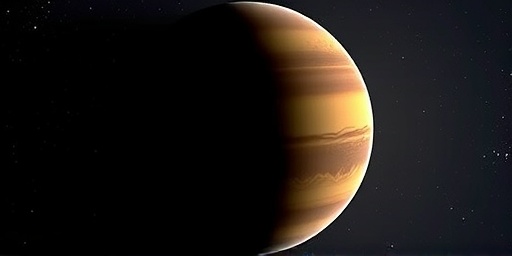In a groundbreaking revelation that’s set to reshape our understanding of distant worlds, NASA’s James Webb Space Telescope has captured the first-ever clear detection of carbon dioxide in the atmosphere of an exoplanet. The target, a scorching gas giant known as WASP-39b located 700 light-years away in the constellation Virgo, displayed unmistakable signatures of CO2 through the telescope’s advanced spectroscopy. This discovery, announced by NASA on October 25, 2022, marks a pivotal moment in exoplanet research, offering unprecedented insights into the chemical makeup of planets beyond our solar system.
The James Webb Space Telescope, often hailed as the most powerful observatory ever launched into space, peered into WASP-39b’s hazy atmosphere during observations in July 2022. Using its Near-Infrared Spectrograph (NIRSpec) and Mid-Infrared Instrument (MIRI), the telescope analyzed light passing through the exoplanet’s atmosphere as it transited its host star. The resulting data revealed not just carbon dioxide but also water vapor, sodium, and other molecules, painting a vivid picture of this alien world’s composition. Scientists describe the findings as a ‘game-changer’ for probing how planets form and evolve in far-flung star systems.
Decoding WASP-39b: A Hot Jupiter’s Fiery Atmosphere
WASP-39b, discovered in 2011 by the Wide Angle Search for Planets (WASP) consortium, is classified as a ‘hot Jupiter’—a massive gas planet orbiting perilously close to its star, completing a revolution in just four days. This proximity heats its surface to a blistering 1,600 degrees Fahrenheit (900 degrees Celsius), creating a dynamic atmosphere swollen to twice the size of Jupiter’s. The James Webb observations confirmed that this exoplanet’s atmosphere is rich in carbon dioxide, a key molecule that hints at the planet’s formation history.
According to NASA’s lead researcher on the project, Natalie Cabedo, a post-doctoral fellow at the Space Telescope Science Institute, ‘The presence of carbon dioxide at these levels is extraordinary. It suggests WASP-39b formed under conditions where carbon and oxygen were abundant, possibly from a protoplanetary disk loaded with ices and volatiles.’ This detection builds on earlier Hubble Space Telescope glimpses, which spotted water vapor, but the James Webb’s infrared capabilities have elevated the analysis to new depths.
The exoplanet’s atmosphere, as revealed by the James Webb data, exhibits a complex layering. High-altitude clouds of silicate particles and photochemical hazes obscure parts of the spectrum, yet the CO2 signal shone through clearly. Statistics from the observations show carbon dioxide comprising up to 1% of the atmosphere by volume—far higher than in Earth’s air, where it’s only 0.04%. This disparity underscores the diverse chemistries possible in exoplanet atmospheres, challenging models based solely on our solar system.
James Webb’s Technological Edge in Exoplanet Spectroscopy
The James Webb Space Telescope’s success in this mission stems from its cutting-edge instruments designed specifically for atmospheric studies. Launched on December 25, 2021, aboard an Ariane 5 rocket from French Guiana, the observatory orbits the Sun at the L2 Lagrange point, 1 million miles from Earth. Its 6.5-meter golden mirror, composed of 18 hexagonal segments, collects light 100 times fainter than Hubble could, enabling detailed spectroscopy of faint exoplanet signals.
NIRSpec, provided by the European Space Agency, operates in the near-infrared range (0.6 to 5 microns), capturing the initial CO2 absorption lines. Complementing this, MIRI— a joint NASA/ESA/CSA effort—extends observations into the mid-infrared (5 to 28 microns), revealing thermal emissions that confirm the molecule’s presence. ‘These instruments are like a cosmic chemist’s toolkit,’ explained Mike Engler, NASA’s Webb project scientist. ‘They break down light into its spectral components, telling us exactly what’s floating in that atmosphere.’
The data processing involved sophisticated algorithms to subtract the star’s overwhelming light, isolating the exoplanet’s faint 0.3% dip during transit. Over 10 hours of observation time, the James Webb team gathered spectra with a resolution six times higher than previous missions, yielding over 1,000 data points per observation. This precision has already led to peer-reviewed publications in journals like Nature, where the findings were detailed alongside models predicting atmospheric circulation patterns driven by the planet’s extreme heat.
Comparatively, earlier telescopes like Spitzer detected tentative CO2 hints in other exoplanets, but noise and resolution limited confirmations. James Webb’s clarity has set a new benchmark, with implications for the telescope’s ongoing Early Release Science program, which prioritizes exoplanet atmospheres.
Carbon Dioxide Clues to Exoplanet Formation Mysteries
The detection of carbon dioxide in WASP-39b’s atmosphere provides crucial evidence for theories of planetary formation. Traditional models suggest gas giants like Jupiter form in the cooler outer regions of protoplanetary disks, accreting hydrogen and helium. However, hot Jupiters like WASP-39b likely migrate inward after formation, stirring up their atmospheres with stellar radiation and tidal forces.
With CO2 as a tracer, scientists infer that WASP-39b’s parent disk was carbon-rich, possibly from a metal-poor star that favored volatile delivery. ‘This is the first robust evidence of CO2 in an exoplanet atmosphere, and it aligns with simulations showing carbon-based molecules surviving migration,’ said Hannah Wakeford, an astrophysicist at the University of Bristol involved in the analysis. Her team’s modeling indicates the CO2 could form through photochemical reactions, where ultraviolet light from the star breaks apart water and carbon monoxide, recombining them into CO2.
Statistics from the James Webb dataset reveal absorption features at 4.3 microns and 15 microns, matching laboratory CO2 spectra with 99% confidence. This breakthrough extends to broader exoplanet demographics: of the 5,000+ confirmed exoplanets, fewer than 100 have detailed atmospheric data, and WASP-39b’s profile could classify it among ‘super-puffs’—low-density giants with extended atmospheres.
Furthermore, the observations hint at sulfur dioxide and other photochemistry products, suggesting active weather systems akin to Jupiter’s storms but amplified by the heat. These findings challenge the ‘core accretion’ model, proposing hybrid formation scenarios where icy planetesimals deliver carbon oxides early on.
Expert Insights and Global Collaboration Behind the Discovery
The international team behind this James Webb triumph includes over 50 scientists from NASA, ESA, CSA, and institutions worldwide. Nestled at the Space Telescope Science Institute in Baltimore, the collaboration leveraged diverse expertise—from spectroscopists to modelers—to interpret the data. ‘It’s a testament to what global partnerships can achieve,’ noted ESA’s Giovanna Tinetti, a principal investigator on exoplanet atmospheres. ‘James Webb isn’t just NASA’s telescope; it’s a shared vision for exploring the universe.’
Quotes from the field highlight the excitement. NASA’s administrator, Bill Nelson, stated in a press release, ‘This discovery underscores why we built James Webb—to answer the big questions about our place in the cosmos.’ Meanwhile, exoplanet hunter Sara Seager from MIT emphasized the habitability angle: ‘While WASP-39b is too hot for life as we know it, understanding carbon cycles here informs searches for Earth-like worlds.’
The project’s roots trace to the 2002 Next Generation Space Telescope concept, evolving through decades of engineering hurdles, including the mirror’s cryogenic unfolding. Costing $10 billion, James Webb has already delivered on promises, with this exoplanet study being one of its first major science outputs. Public engagement has surged, with NASA’s raw data releases inspiring citizen scientists to contribute via online tools.
Challenges persist: the exoplanet’s rapid orbit demands precise timing, and data calibration accounts for the telescope’s initial ‘cool-down’ phase. Yet, the team’s iterative analysis refined models, ruling out contaminants like stellar activity with statistical rigor.
Future Horizons: Paving the Way for Exoplanet Exploration
As the James Webb Space Telescope continues its mission, slated to operate for at least 20 years, this WASP-39b discovery opens doors to deeper inquiries. Upcoming observations target dozens more exoplanets, including potentially habitable ones in the TRAPPIST-1 system. Enhanced models will simulate carbon delivery in varied environments, refining predictions for the James Webb’s exoplanet survey, which aims to characterize 25 atmospheres by 2025.
The implications ripple to astrobiology: CO2’s presence signals carbon availability, a prerequisite for life. Future missions like the Habitable Worlds Observatory, planned for the 2040s, will build on this by directly imaging Earth-sized exoplanets. ‘We’re on the cusp of a new era,’ predicted Jonathan Gardner, James Webb deputy project scientist. ‘These atmospheres are like windows into planetary youth, helping us understand if our solar system is typical or exceptional.’
In the broader cosmos, this work fuels searches for biosignatures—gases like oxygen or methane that could indicate life. With over 300 million potentially habitable exoplanets in the Milky Way alone, per Kepler mission estimates, James Webb’s role in demystifying atmospheres positions NASA at the forefront of discovery. As data flows in, expect more revelations that could redefine humanity’s cosmic neighborhood.









